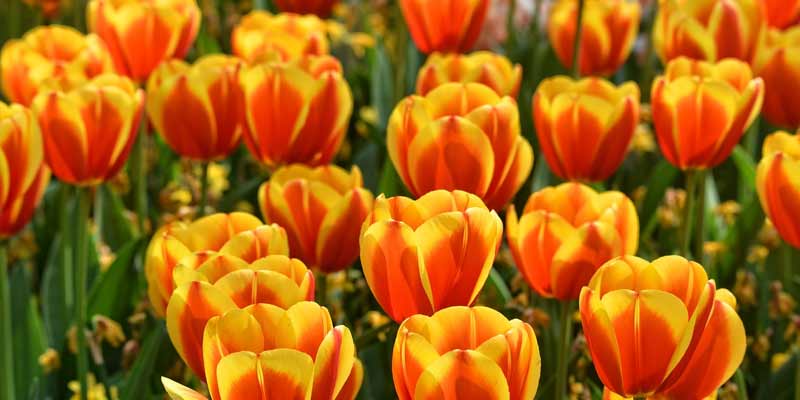With their vibrant hues and graceful blooms, tulips symbolize spring’s arrival; they awaken gardens after the dreary winter months with bursts of color. Gardeners worldwide cherish these iconic flowers for their beauty: indeed, it is this versatility that makes them so beloved. Yet—achieving that picture-perfect tulip display requires careful planning; in particular, one must time the planting correctly.
This comprehensive guide delves into the intricacies of tulip planting, it explores optimal timing, preparation, and techniques for cultivating these delightful flowers in your garden.
Understanding Tulip Planting Seasons
To comprehend the optimal planting time for tulips, it is indispensable to first grasp their innate growth cycle and the environmental conditions that foster their flourishing. Originating from the perennial bulbs in Central Asia’s mountainous regions, tulips encounter distinct seasons marked by cold winters and warm but arid summers.
Tulips, in temperate climates, typically bloom during the spring, they offer an awe-inspiring display of color throughout gardens; parks and landscapes become vibrant with their presence. Nevertheless, the timing for planting tulips differs depending on geographical location and prevailing climate patterns.
Determining the Optimal Planting Time
Your climate zone and prevailing weather conditions in your region significantly influence the ideal time for planting tulips. Generally, one should plant tulip bulbs during autumn, a period well before ground freezing occurs; this allows them to develop roots prior to winter dormancy starting.
Late September to mid-November typically represents the prime planting window for tulips in regions characterized by cold winters and temperate climates; these may include sections of North America and Europe. By ensuring bulb settlement into the soil during this period, we guarantee sufficient time for them to develop robust root systems before winter’s chilling effect takes hold.
Tulips thrive in warmer climates, such as the Mediterranean or parts of the southern United States with milder winters. Consequently, you can plant them a bit later, typically from late November to December. Nevertheless; it remains crucial to monitor soil temperatures and strategically aim for bulb planting before prolonged cold spells set in.
Factors Influencing Tulip Planting Time
The timing of tulip planting hinges upon various factors: climate, soil conditions, and the specific variety one intends to cultivate. Bear in mind these key considerations, that are crucial for a successful cultivation process:
1. Soil Temperature: Tulip bulbs necessitate cool soil temperatures for root growth initiation without prematurely sprouting. Aim to sow tulips when the soil’s temperature drops to approximately 50°F (10°C) or lower; this guarantees optimal conditions conducive to robust root development.
2. Frost Risk: In regions predisposed to late-season frosts, the risk of planting tulips too early lies in potentially exposing emerging shoots to frost damage; this jeopardizes your spring display’s success. Aim for a time when local weather forecasts indicate diminishing risks of frost before you plant those tulips.
3. Variety Selection: Various tulip varieties demonstrate diverse growth habits and flowering times; for instance, ‘Kaufmanniana’ and ‘Greigii’—early-blooming options—are ideal for planting slightly ahead of mid- or late-season variants. This strategy—staggering the bloom period—not only enhances spring’s floral spectacle but also prolongs it.
Preparing for Planting
To ensure optimal growth and flowering of tulip bulbs, one must prepare the planting site properly before actually planting them. The following steps are essential for effective preparation prior to tulip plantation:
1. Site Selection: For tulip planting, select a location: it should be well-drained and bathed in ample sunlight. Steer clear of areas prone to waterlogging or stagnant water accumulation, excessive moisture may induce bulb rot and fungal diseases.
2. Soil Preparation: Loosen the soil to a depth of 8-10 inches (20-25 cm); incorporate organic matter, such as compost or aged manure – this will enhance both soil structure and fertility. Before initiating planting procedures, ascertain that there are no weeds or debris within the soil.
3. Planting Depth and Spacing: Tulip bulbs require a planting depth approximately three times their own diameter; position them with the pointed end facing upward. To facilitate proper root development and air circulation, space each bulb at least 4 to 6 inches–equivalent to 10 to 15 centimeters apart.
4. Mulching: Insulate the soil and regulate winter moisture levels by applying a layer of mulch straw or shredded bark, for instance. Additionally, mulching suppresses weed growth and shields bulbs from temperature fluctuations.
Caring for Tulips
After planting, tulip bulbs demand minimal maintenance; however, they thrive with regular care to guarantee robust growth and copious flowering. Consider the following indispensable tips for nurturing your tulip bulbs
1. Watering: Although tulip bulbs exhibit a relative tolerance to drought, they require consistent moisture during the establishment phase and all through their growth season; thus, you must provide ample water for newly planted tulip bulbs immediately after planting. Keep an especially vigilant eye on soil moisture levels in periods of dry weather.
2. Fertilization: During the growing season, apply a balanced fertilizer specifically formulated for bulbs or opt for a slow-release one; this will provide your plants with essential nutrients, promoting vigorous growth and flowering. However, be cautious of excessive nitrogen fertilizers, as they may promote lush foliage at the cost of flowers.
3. Pest and Disease Management: Vigilantly monitor for prevalent pests including aphids, slugs, and rodents that ravage bulbs; then implement suitable measures to control infestations. By adopting proper sanitation practices, specifically removing spent foliage and debris— you can significantly reduce the risk of fungal diseases as well as bulb rot.
4. Deadheading: Promptly remove faded flowers to avert seed pod formation and conserve the plant’s energy for bulb development; concurrently, this practice, by fostering a tidy appearance stimulates the plant towards reassigning resources for bulb multiplication.
Conclusion
Understanding the optimal planting time, preparing the site for planting, and providing proper care promise a breathtaking display of tulips in your garden each spring. Embark on this rewarding endeavor: roll up your sleeves; and grab gardening tools, a journey awaits you to create an uplifting tapestry that heralds spring’s arrival with vibrant color and vitality!



Leave a Reply